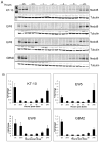Initial testing of the investigational NEDD8-activating enzyme inhibitor MLN4924 by the pediatric preclinical testing program
- PMID: 22012946
- PMCID: PMC3823062
- DOI: 10.1002/pbc.23357
Initial testing of the investigational NEDD8-activating enzyme inhibitor MLN4924 by the pediatric preclinical testing program
Erratum in
- Pediatr Blood Cancer. 2012 Oct;59(4):772
Abstract
Background: MLN4924 is an investigational first-in-class small molecule inhibitor of NEDD8-activating enzyme (NAE). NAE is an essential component of the NEDD8 conjugation pathway, controlling the activity of a subset of ubiquitin-proteasome system (UPS) E3 ligases, multiprotein complexes that transfer ubiquitin molecules to substrate proteins.
Procedures: MLN4924 was tested against the PPTP in vitro panel using 96-hour exposure time at concentrations ranging from 1.0 nM to 10 µM. It was tested in vivo at a dose of 100 mg/kg [66 mg/kg for the acute lymphoblastic leukemia (ALL) xenografts] administered orally twice daily × 5 days. Treatment duration was 3 weeks.
Results: The median relative IC(50) for MLN4924 against the PPTP cell lines was 143 nM, (range: 15-678 nM) with that for the Ewing panel being significantly lower (31 nM). MLN4924 induced significant differences in EFS distribution compared to control in 20 of 34 (59%) evaluable solid tumor xenografts. MLN4924 induced intermediate activity (EFS T/C values >2) in 9 of the 33 evaluable xenografts (27%), including 4 of 4 glioblastoma xenografts, 2 of 3 Wilm's tumor xenografts, 2 of 5 rhabdomyosarcoma xenografts, and 1 of 4 neuroblastoma xenografts. For the ALL panel, 5 of 8 evaluable xenografts showed intermediate activity for the EFS T/C measure. MLN4924 did not induce objective responses in the PPTP solid tumor or ALL panels.
Conclusions: MLN4924 showed potent activity in vitro and in vivo showed tumor growth inhibitory activity against a subset of the PPTP solid tumor and ALL xenografts.
Copyright © 2011 Wiley Periodicals, Inc.
Conflict of interest statement
Figures




Similar articles
-
Initial testing of the aurora kinase A inhibitor MLN8237 by the Pediatric Preclinical Testing Program (PPTP).Pediatr Blood Cancer. 2010 Jul 15;55(1):26-34. doi: 10.1002/pbc.22430. Pediatr Blood Cancer. 2010. PMID: 20108338 Free PMC article.
-
Initial testing of JNJ-26854165 (Serdemetan) by the pediatric preclinical testing program.Pediatr Blood Cancer. 2012 Aug;59(2):329-32. doi: 10.1002/pbc.23319. Epub 2011 Sep 15. Pediatr Blood Cancer. 2012. PMID: 21922647 Free PMC article.
-
MLN4924, a NEDD8-activating enzyme inhibitor, is active in diffuse large B-cell lymphoma models: rationale for treatment of NF-{kappa}B-dependent lymphoma.Blood. 2010 Sep 2;116(9):1515-23. doi: 10.1182/blood-2010-03-272567. Epub 2010 Jun 4. Blood. 2010. PMID: 20525923
-
MLN4924: a novel first-in-class inhibitor of NEDD8-activating enzyme for cancer therapy.Expert Opin Investig Drugs. 2012 Oct;21(10):1563-73. doi: 10.1517/13543784.2012.707192. Epub 2012 Jul 16. Expert Opin Investig Drugs. 2012. PMID: 22799561 Review.
-
Neddylation Pathway as a Novel Anti-cancer Target: Mechanistic Investigation and Therapeutic Implication.Anticancer Agents Med Chem. 2015;15(9):1127-33. doi: 10.2174/1871520615666150305111257. Anticancer Agents Med Chem. 2015. PMID: 25742093 Review.
Cited by
-
Pediatric brain tumor cell lines.J Cell Biochem. 2015 Feb;116(2):218-24. doi: 10.1002/jcb.24976. J Cell Biochem. 2015. PMID: 25211508 Free PMC article.
-
A review of new agents evaluated against pediatric acute lymphoblastic leukemia by the Pediatric Preclinical Testing Program.Leukemia. 2016 Nov;30(11):2133-2141. doi: 10.1038/leu.2016.192. Epub 2016 Jul 15. Leukemia. 2016. PMID: 27416986 Review.
-
The NEDD8-activating enzyme inhibitor MLN4924 induces DNA damage in Ph+ leukemia and sensitizes for ABL kinase inhibitors.Cell Cycle. 2019 Sep;18(18):2307-2322. doi: 10.1080/15384101.2019.1646068. Epub 2019 Jul 26. Cell Cycle. 2019. PMID: 31349760 Free PMC article.
-
The Anti-Tumor Activity of the NEDD8 Inhibitor Pevonedistat in Neuroblastoma.Int J Mol Sci. 2021 Jun 18;22(12):6565. doi: 10.3390/ijms22126565. Int J Mol Sci. 2021. PMID: 34207315 Free PMC article.
-
Neddylation of sterol regulatory element-binding protein 1c is a potential therapeutic target for nonalcoholic fatty liver treatment.Cell Death Dis. 2020 Apr 24;11(4):283. doi: 10.1038/s41419-020-2472-6. Cell Death Dis. 2020. PMID: 32332706 Free PMC article.
References
-
- Brownell JE, Sintchak MD, Gavin JM, et al. Substrate-assisted inhibition of ubiquitin-like protein-activating enzymes: the NEDD8 E1 inhibitor MLN4924 forms a NEDD8-AMP mimetic in situ. Molecular cell. 2010;37(1):102–111. - PubMed
-
- Milhollen MA, Narayanan U, Soucy TA, et al. Inhibition of NEDD8-activating enzyme induces rereplication and apoptosis in human tumor cells consistent with deregulating CDT1 turnover. Cancer research. 2011;71(8):3042–3051. - PubMed
-
- Soucy TA, Smith PG, Milhollen MA, et al. An inhibitor of NEDD8-activating enzyme as a new approach to treat cancer. Nature. 2009;458(7239):732–736. - PubMed
-
- Milhollen MA, Traore T, Adams-Duffy J, et al. MLN4924, a NEDD8-activating enzyme inhibitor, is active in diffuse large B-cell lymphoma models: rationale for treatment of NF-{kappa}B-dependent lymphoma. Blood. 2010 - PubMed
Publication types
MeSH terms
Substances
Grants and funding
LinkOut - more resources
Full Text Sources
Medical
Miscellaneous

